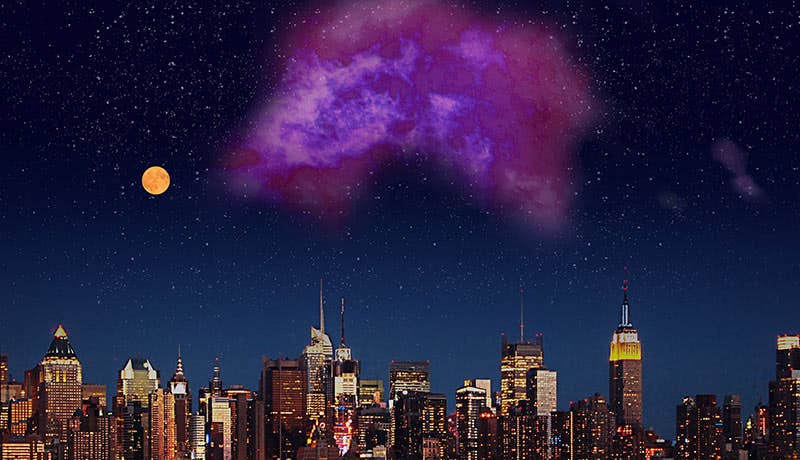Astronomers discover massive star-forming cloud near our solar system
Astronomers discover Eos, a giant hydrogen cloud near Earth, using ultraviolet light, revolutionizing our understanding of star formation.

Artist’s conception of what the Eos molecular cloud would look like in the sky if it were visible to the naked eye.
(CREDIT: Composite image: Nature Life Photo /Flickr (New York City Skyline), Burkhart et al. 2025)
Astronomers have discovered a massive hydrogen cloud, known as Eos, shining brightly in ultraviolet light near our solar system. This newly detected cloud offers fresh insights into how stars and planets form, reshaping how scientists understand interstellar space.
Discovery Illuminates Hidden Space
The team, led by Blakesley Burkhart from Rutgers University-New Brunswick, found Eos by tracking its ultraviolet glow. Usually, clouds like Eos remain hidden, invisible to traditional methods. Most astronomers rely on carbon monoxide signals to spot such clouds, but this new approach directly detects molecular hydrogen—the main component of these cosmic nurseries.
“This opens up new possibilities for studying the molecular universe,” Burkhart said. Previously, detecting hydrogen clouds was notoriously difficult due to the nature of hydrogen itself. Hydrogen gas does not easily emit detectable signals at typical cold temperatures in space. Instead, scientists typically rely on other molecules like carbon monoxide to trace these clouds.
The team's method involved observing ultraviolet fluorescence from hydrogen gas. Fluorescence occurs when hydrogen absorbs high-energy ultraviolet photons and then re-emits this energy as light. Eos became visible as hydrogen molecules within it emitted a faint glow in the far ultraviolet spectrum, something never before used to discover a molecular cloud.
Close Proximity, Huge Potential
Located about 300 light-years away, Eos lies at the edge of the Local Bubble, a large cavity in space surrounding our solar system. Scientists estimate Eos spans roughly "40 moons across the sky," making it one of the largest known structures near Earth.
Despite its enormous size, Eos had remained invisible because it doesn't contain enough carbon monoxide to be spotted by conventional techniques. Its discovery challenges previous beliefs about the rarity and visibility of such large molecular structures.
Related Stories
The Local Bubble itself formed from multiple supernovae, creating a hot, empty area encased by a shell of gas and dust. Eos sits precisely on this shell, providing astronomers a unique opportunity to study interactions between stellar explosions and cloud formations.
“The cloud is literally glowing in the dark,” Burkhart noted. She emphasized the significance of finding such a massive structure so close to Earth, as it provides unprecedented access for studying star formation in detail.
Eos’s Brief Existence
Using sophisticated simulations and new analytical models, the researchers determined Eos is relatively short-lived, predicting it will vanish in about six million years. This fleeting lifespan highlights how quickly stellar environments can change, influenced by stellar winds, radiation, and supernova explosions.
Eos’s transient nature makes it an excellent laboratory to explore how molecular clouds evolve, form stars, and eventually disperse. Burkhart explained, “Our discovery of Eos is exciting because we can now directly measure how molecular clouds are forming and dissociating, and how a galaxy transforms interstellar gas into stars and planets.”
The researchers found minimal carbon monoxide within Eos, classifying it as a "CO-dark" cloud. This discovery confirms theories that vast amounts of molecular hydrogen may exist undetected in our galaxy, hidden from traditional detection methods.
Revolutionary Technique, Broader Applications
The technique used by Burkhart’s team involves ultraviolet spectroscopy. Specifically, the Far-Ultraviolet Imaging Spectrograph (FIMS), operating aboard the Korean satellite STSAT-1, gathered data from 2003 to 2005. Although this information became publicly available only recently, Burkhart realized its untapped potential.
“It was kind of like just waiting to be explored,” she said. The technique could revolutionize the understanding of interstellar space, potentially uncovering many more hidden molecular clouds across the galaxy and beyond.
Thavisha Dharmawardena, a NASA Hubble Fellow from New York University, underscored the method's novelty. “When I was in graduate school, we were told that you can’t easily directly observe molecular hydrogen,” she remarked. “It’s kind of wild that we can see this cloud in data that we didn’t think we would see.”
Their research, published in Nature Astronomy, not only redefines the approach to observing molecular clouds but also holds implications for future space missions. Burkhart and her team are supporting a proposed NASA mission also named Eos, designed to use similar techniques to scan broader regions of the galaxy.
Furthermore, the team continues its quest for molecular hydrogen clouds using the James Webb Space Telescope (JWST). They recently reported a tentative detection of what might be the farthest molecular gas cloud ever observed, again using ultraviolet fluorescence methods. “Using JWST, we may have found the very furthest hydrogen molecules from the sun,” said Burkhart, emphasizing how transformative this technique might be for astronomy.
In essence, the discovery of Eos reshapes scientific views of our cosmic neighborhood, shining a literal and figurative light on the mysteries of the universe’s building blocks.
Note: The article above provided above by The Brighter Side of News.
Like these kind of feel good stories? Get The Brighter Side of News' newsletter.



